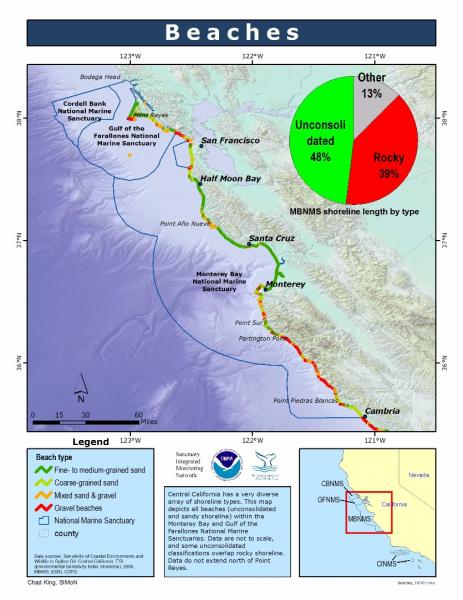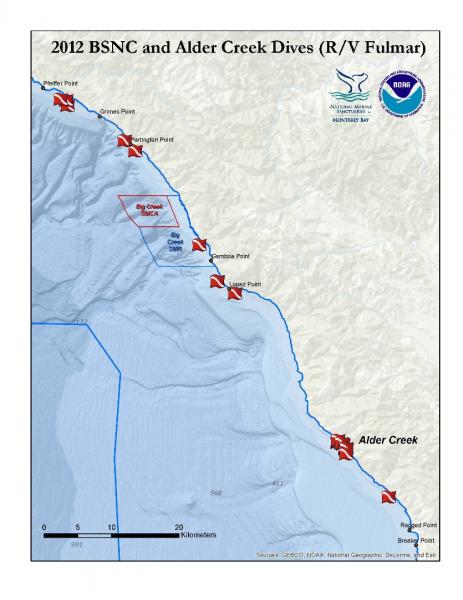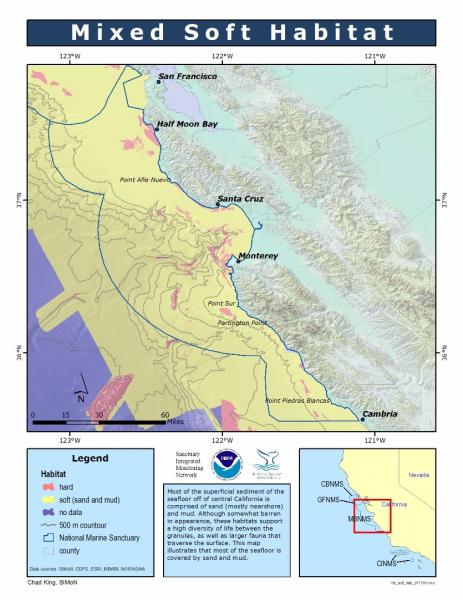Overview
The seafloor landscape of the Greater Farallones National Marine Sanctuary is active, varied and beautiful – much like the land above the water. This underwater landscape is the cumulative result of millions of years of the earth’s history, involving many phenomena, including the building and subsequent wearing down of mountains, movement during large and small earthquakes, changes in sea level, and the never-ending processes of wind and water erosion and deposition of bottom sediments.
The sanctuary straddles the boundary zone between two of the earth’s major tectonic plates: the Pacific and North American. The Pacific Plate is slowly moving northward relative to the North American Plate at an average rate of about five centimeters (two inches) per year. Most of this motion occurs in catastrophic bursts of movement – earthquakes – along the San Andreas Fault system.
Near San Francisco, the San Andreas Fault system is a complex zone of faults about 80 kilometers (50 miles) wide. It stretches from the sanctuary as far east as the cities of Vallejo and Livermore. Two of the system’s major faults, the San Andreas and the San Gregorio, merge into one fault zone in the sanctuary just offshore from the Golden Gate Bridge.
The San Andreas Fault zone splits Bolinas Lagoon, Tomales Bay and Bodega Bay. It is responsible for the long, straight, narrow shape of Tomales Bay.
West of the fault, Bodega Head, the Farallon Islands and Point Reyes Peninsula are made of granitic bedrock believed to be originally from the southern Sierra Nevada. These landmasses and the surrounding submerged lands ride on the Pacific Plate northward relative to the adjacent North American Plate. Most of Marin County is east of the Fault, which is on the North American Plate.
The famous 1906 San Francisco earthquake, with a magnitude of 7.8 on the Richter Scale, began on a segment of the San Andreas Fault that lies underwater adjacent to the sanctuary, just a few miles offshore of San Francisco. During this one earthquake, the Pacific Plate underlying the sanctuary lurched 4.5 to 6 meters (15 to 20 feet) north relative to the North American Plate to the east.
Sediment cores from eastern Bolinas Lagoon (North American Plate) indicate that this portion of the lagoon became deeper as a result of this earthquake, due to shaking-induced compaction and basin subsidence. The lagoon has since been filling in with sediment from terrestrial watersheds and the ocean, increasing the amount of salt marsh and frequently-exposed mudflat habitats while decreasing the amount of submerged habitat. It is thought that when another large earthquake occurs in this area, the east side of Bolinas Lagoon may again deepen and experience a natural shift toward submerged habitats.
Interesting geology, knobs formed by the differential erosion of sedimentary rock. This is just at the base of the cliff jutting southwest-most at Pillar Point.
Offshore of Tomales Bay and Bolinas Lagoon, the sanctuary is characterized by a gently seaward-sloping continental shelf area that is approximately 55 kilometers wide. The western edge of the shelf is currently in 90 meters of water depth and coincides with the shoreline of the last ice age.
As recently as about 10,000 years ago, at the end of the last ice age, the great sheets of ice (glaciers) that covered much of the earth’s northern hemisphere began melting – causing worldwide sea level to rise. Sea level rose to its present-day position within 5,000 years. In that time, the continental shelf portion of the sanctuary was flooded and Tomales Bay, Bolinas Lagoon, Estero Americano and Estero de San Antonio became estuaries.
Since much of the sanctuary seafloor is too deep for human divers, scientists have learned much about it by using acoustic instruments (those that use sound sources and listening devices) and underwater cameras and video equipment. Data collected from the sanctuary continental shelf reveal various features on the seabed, including linear trends of biologically diverse rocky outcrops and several types of sand wave features, such as giant undersea sand dunes. West of the continental shelf, the water depth steeply increases over the rugged seafloor, indented by numerous submarine canyons.
Monitoring
The following list includes some of the projects underway in the sanctuary. Please click on the Projects tab at the top of this page for more information.
usSEABED Database
The USGS has spearheaded a major ongoing effort to gather diverse geologic data about the continental shelf and organize it through a GIS database. This project, called usSEABED, is an innovative system developed to use both lab-based analyses and numeric data from descriptive data together in a unified database. The database provides unprecedented coverage of the sediment and rock types sampled from the seafloor as well as a searchable catalog of other observations, such as micro and macro flora and fauna and sedimentary structures.
Photos
Maps
Shoreline type along the central California coastline

[View Larger]
2012 Big Sur Nearshore Characterization and Alder Creek Dives

[View Larger]
Mixed Soft Habitat

[View Larger]
Projects
Northern Central California Coast State Waters Mapping Project (NCCMP)
This project maps the state water seafloor habitats (MHHW out to 3 nm) from Año Nuevo to Bolinas (NCCMP Phase I) using bathymetric LIDAR and multibeam echo sounders (MBES) to obtain both bathymetry data and acoustic backscatter and reflectance imagery.Seafloor Mapping in Monterey Bay, Cordell Bank, and Gulf of the Farallones National Marine Sanctuaries
National Oceanic and Atmospheric Administration and U.S. Geological Survey scientists mapped and characterized seafloor areas on the continental shelf in three west coast National Marine Sanctuaries using side-scan sonar and underwater video technology.usSEABED: A USGS Pacific Coast Offshore Surficial Sediment Data and Mapping Project
The USGS will soon publish its first release of Pacific coast data from the usSEABED database, a map-based compilation of offshore surficial sediment data.Links
Big Sur Region Earth Sciences Bibliography
A compilation of citations pertaining to Earth sciences studies performed in the Big Sur region of central coastal California.http://www.ventanawild.org/news/fe02/geobib.html
California Coastal Commission - 1995 ReCAP Pilot Project, Monterey Bay Region: Coastal Hazards
This chapter summarizes ReCAP's investigation of shoreline hazard response -- protection of upland development by armoring, the permitting associated with existing armoring, the impacts from armoring, the policies which address shoreline protection, and the likely changes which will happen to the shoreline in the future assuming existing trends and policies continue.http://www.coastal.ca.gov/recap/chap3.html
California Coastal Mapping Project
The California Coastal Mapping Program is a comprehensive effort to combine seafloor mapping data with shoreline data to create seamless onshore-offshore maps of California's coastline.http://www.opc.ca.gov/2010/01/mapping-californias-coastal-areas/
California Geological Survey - An index to online geologic field trips, including coastal Central California
The California Geotour is an interactive index of Web pages of geologic field trip guides and related Web sites compiled by the California Geological Survey (CGS) for the benefit of all who have wondered about California's geologic features.http://www.conservation.ca.gov/cgs/Pages/Geotours.aspx
Central Coast Watershed Studies (CCoWS)
The Central Coast Watershed Studies (CCoWS) team is part of the Watershed Institute, in the Division of Science and Environmental Policy at California State University Monterey Bay. They conduct research on watersheds that feed into the MBNMS.http://ccows.csumb.edu/home/
CSUMB Seafloor Mapping Lab
At California State University Monterey Bay, students get hands-on research experience with mapping the seafloor. Find out more!http://seafloor.csumb.edu/index.html
Elkhorn Slough Tidal Wetland Plan
The purpose of this collaborative planning process is to conserve, enhance, and restore tidal habitats in the Elkhorn Slough watershed by developing strategies to address hydrological management issues.http://elkhornslough.org/tidalwetlandplan.htm
Investigating Earth Systems
A new, standards-based, Earth Science curriculum for the middle grades developed by the American Geological Institute in association with It's About Time Publishing.http://www.agiweb.org/ies/
MBARI - Current Research Projects
Learn about current research projects conducted by the Monterey Bay Aquarium Research Institute (MBARI).http://www.mbari.org/rd/projects/current_projects.html
MBARI - Mapping the Monterey Canyon
See how the Monterey Bay Aquarium Research Institute (MBARI) is involved in mapping the seafloor of the Monterey Bay National Marine Sanctuary.http://www.mbari.org/canyon/Mapping_Sections.htm
MBNMS Teacher Curriculum - The Land-Sea Connection
Teacher activity "The Land-Sea Connection": Conducting a Transect Along the Seafloor of the Monterey Bay National Marine Sanctuary, takes students in for a close look at the Sanctuary's benthic region. After becoming familiar with a bathymetric/topographic map of the area, students select a transect along the seafloor to study some of the geological, biological, and physical features that are present. Available in both Spanish and English.http://montereybay.nos.noaa.gov/educate/teachercurriculum/investigation2.html
Monterey Bay Aquarium - Student and Teacher Resources and Activities
The Monterey Bay Aquarium offers teacher and student resources including: species and habitat-specific information, live cams, classroom activities, and interactive online games.http://www.mbayaq.org/lc/
Monterey Bay National Marine Sanctuary Site Characterization - Geology
This site characterization of the Monterey Bay National Marine Sanctuary (MBNMS) summarizes available information about MBNMS geology.http://montereybay.noaa.gov/sitechar/geol.html
NOAA - Ocean Exploration Lesson Plans
Students of all ages can learn about the oceans with near real-time access to a series of multidisciplinary deep ocean explorations. The site offers a set of over 100 hands-on and standards-based lesson plans for student exploration and discovery. Using new technological "eyes" to see, sense, measure, image, and describe a little known ocean world, these lessons bring the excitement of late-breaking ocean discoveries into classrooms.http://oceanexplorer.noaa.gov/explorations/06davidson/background/edu/lessonplans.html
Oceanography Resources- Educational resources
This includes links to online courses about oceanography, museum and university exhibitions, sites dealing with significant oceanographic field programs and experiments, technical reports, glossaries and various other documents pertaining to oceanography and related areas.http://stommel.tamu.edu/%7Ebaum/ocean_education.html
Smithsonian Education - Ocean Planet Lesson Plan
Part of a set of multidisciplinary lesson plans from the Smithsonian, this lesson plan focuses on the ocean bottom features such as the continental shelf, deep ocean plain, and mid-ocean ridges, and includes downloadable student activities. Grades 3-8.http://www.smithsonianeducation.org/educators/lesson_plans/ocean/secrets/essay.html
Teach the Earth - Education Tools and Information for the Geosciences
The Science Education Resource Center's portal for Geoscience Faculty, providing information and resources to undergraduate educators. Much of the information is useful for high school teachers as well.http://serc.carleton.edu/
The Bridge - Ocean Sciences Teacher Resource Center
Materials and curricula related to many areas of study in the Monterey Bay. Be sure to check the data tip of the month archives. (Supported by the National Sea Grant Office, the National Oceanographic Partnership Program, and the National Marine Educators Association.)http://www.vims.edu/bridge/
USGS - Geology and Coastal Hazards in the Northern Monterey Bay, California, A Field Trip Guidebook
The purpose of this field trip is to explore the relationships between local geology, coastal hazards, and human influences in the northern Monterey Bay, which is a tectonically active, high wave energy coastal environment.http://geopubs.wr.usgs.gov/open-file/of00-438/
USGS - Geology and Coastal Hazards in the Northern Monterey Bay, California, A Field Trip Guidebook
The purpose of this field trip is to explore the relationships between local geology, coastal hazards, and human influences in the northern Monterey Bay, which is a tectonically active, high wave energy coastal environment.http://geopubs.wr.usgs.gov/open-file/of00-438/
USGS - Monterey Bay Internet Map Server
Continental Shelf GIS for the Monterey Bay Area - selected data layers for the USGS seafloor for the Monterey Bay National Marine Sanctuary Project from USGS published reports and other sources.http://coastalmap.marine.usgs.gov/ArcIMS/website/usa/westcoast/cencal/montereybay/viewer.htm
USGS - Photo Tour from Año Nuevo to Santa Cruz, California
A digital photographic survey documenting the coastal morphology and stratigraphy between Point Año Nuevo and Santa Cruz, California, with precision-navigated overlapping images.http://pubs.usgs.gov/dds/dds-61/
USGS - Science Education
The U.S. Geological Survey (USGS) provides scientific information intended to help educate the public about natural resources, natural hazards, geospatial data, and issues that affect our quality of life. This website provides links to selected online resources to support education (K-12) and college inquiry and research.http://education.usgs.gov/
USGS Pacific Coastal & Marine Science Center
Homepage of USGS Division that conducts multidisciplinary scientific research in the coastal and offshore areas of California, Oregon, Washington, Alaska, Hawaii, and other US Pacific Islands; and in other waterways of the United States.http://walrus.wr.usgs.gov
USGS Western Region Coastal and Marine Geology - Education and Outreach Activities
Online education and outreach activities highlight geologic information helpful for the public, educators, students, scientists, businesses, and government agencies.http://walrus.wr.usgs.gov/pubinfo/